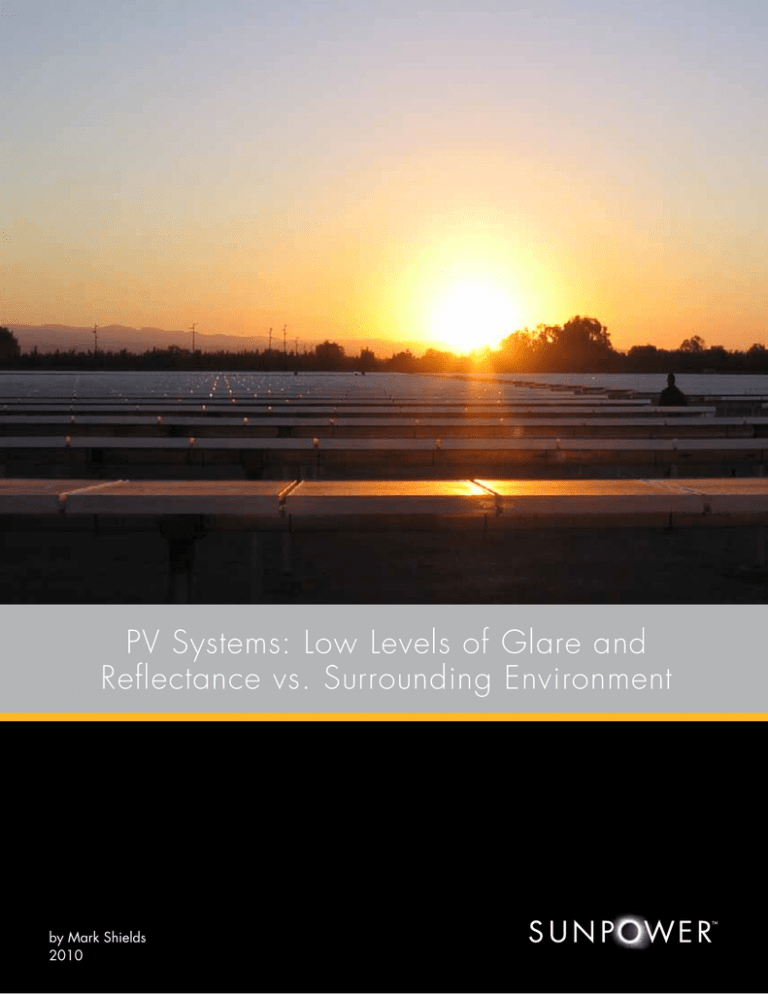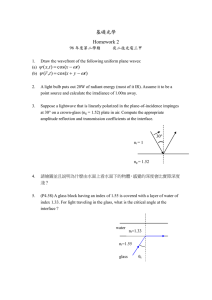
PV Systems: Low Levels of Glare and
Reflectance vs. Surrounding Environment
by Mark Shields
2010
EXECUTIVE SUMMARY
The glare and reflectance levels from a given PV system are decisively lower than the glare and reflectance
generated by the standard glass and other common reflective surfaces in the environments surrounding the
given PV system. Possibilities of random glare and reflectance observed from the air: the PV industry has
multiple large projects installed near airports or on air force bases. Each of these large projects has passed
FAA or Air Force standards and all projects have been determined as “No Hazard to Air Navigation”.
Although the possible glare and reflectance from PV systems are at safe levels and are decisively lower than
other standard residential and commercial reflective surfaces, it is suggested that customers and installers
discuss any possible concerns with the neighbors/cohabitants near the planned PV system installation.
EXECUTIVE SUMMARY
2
EXPLANATION OF REFLECTANCE AND PV GLASS
SECTION 1
In general, since the whole concept of efficient solar power is to absorb as much light as possible while reflecting
as little light as possible, standard solar panels produce less glare and reflectance than standard window glass.
This is pointed out very well in US patent # 6359212 (Method for testing solar cell assemblies and second surface
mirrors by ultraviolet reflectometry for susceptibility to ultraviolet degradation), which explains the differences in
the refraction and reflection of solar panel glass versus standard window glass. Specifically, on a more technical
level, solar panels use “high-transmission, low-iron” glass, which absorbs more light, producing smaller amounts
of glare and reflectance than normal glass. In order to further explain these differences, we will need to explain
some basic scientific terms that are used when discussing beams of light impacting the surfaces of other mediums,
as the light beams leave air to enter the other mediums.
Reflection, Refraction and Angles-of-incidence
The imaginary line at 90° to a given reflective surface
is called the Normal. The original beam of light is
called the incident beam, and the angle at which it
strikes the surface is called the incident angle. The
quantity of reflected light is called the reflectance, and
the angle at which it leaves the surface is the angle
of reflectance. With transparent surfaces, the amount
of light which bends slightly as it goes through the
surface is called the refracted beam OR transmittance.
These basic concepts of reflection (return of light from
a surface) and refraction (bending and transmission
of light through a surface) are pointed out in the
first two figures on the next page. Both have a
normal, an incident beam and an incident angle;
Figure 1.1; Reflection
E X P L A N AT I O N O F R E F L E C TA N C E A N D P V G L A S S
Figure 1.2: Refraction
SECTION 1
3
SECTION 1
Since our main discussion concerns types of glass and sunlight, we will further our explanation using glass as the
example and speaking in terms of reflected energy percentages:
Incident light and Reflected Energy percentages. When a beam of light falls on a piece of glass, some of the light
is reflected from the glass surface, some of the light passes through the glass (transmitted), and some (very little) is
absorbed by the glass.
•
•
The measure of the proportion of light reflected from the surface is called reflectance (reflection).
The measure of the proportion transmitted is the transmittance (This is where the term high light-
transmission glass comes from because the glass is formulated to allow more light to pass through
its surface than would pass through a standard glass surface).
The measure of the proportion absorbed is the absorptance (absorption (this amount is very small
for clear glass – much, much smaller proportionately, than the other two components).
•
•
Each quantity is expressed as a fraction of the total quantity of light in the beam. If the intensity of
the beam is represented by the numerical 1, reflectance by R, absorptance by A and transmittance
by T, intensity may be expressed as follows: R + A + T = 1, where glass is the glazing material pointed out in figure 2-2 in the next column (Figure 2-1 is a rough depiction of the percentages
of light for each component of the equation).
Figure 2.1: Depiction of resultant percentages for
incident components
Figure 2.2: Solar radiation through a glazing
material is either reflected, transmitted or absorbed
E X P L A N AT I O N O F R E F L E C TA N C E A N D P V G L A S S
SECTION 1
4
SECTION 1
The reflection/refraction behavior of a medium is directly related to its
index of refraction. The lower the index of refraction for a medium, the
less light it reflects because the medium is allowing more of the incident
beam to pass directly through (in our case, directly through the glass
to the solar cells). The following list and graphical representation are
one-to-one in the order of a materials’ representation;
Figure 2.4: Common Reflective Surfaces and reflectance percentages.
Figure 2.3: Common Reflective Surfaces and Index of
Refraction, “n” (the value “n” may vary by reference
source, but the hierarchy of “n” values from one material to another will remain the same).
In the below we show the reflected energy percentages of sunlight,
off of some common residential and commercial surfaces. The legend
and the graph lists the items from top to bottom in order of the highest
percentage of reflected energy (as does the list of Common Reflective
Surfaces); E.g. – ‘Steel’ reflects more energy than ‘Snow’. ‘Snow’
reflects more energy than ‘standard glass’, etc. It should be noted from
the graph and the table below, that the reflected energy percentage
of Solar Glass is far below that of standard glass and more on the
level of smooth water.
Figure 2.5: Common Reflective Surfaces and
reflectance percentage values.
E X P L A N AT I O N O F R E F L E C TA N C E A N D P V G L A S S
SECTION 1
5
SECTION 1
Stippled Glass” and “Light Trapping” In addition to the superior refractive/reflective
properties of solar glass versus standard glass,
many PV suppliers uses stippled solar glass for their
panels. Stippled glass is also used with high powered
telescopes and with powerful beacons and flashlights.
The basic concept behind stippling is for the surfaces
of the glass to be “textured” with small types of
indentations. As a result, stippling allows more light
energy to be channeled/transmitted through the glass
while diffusing (weakening) the reflected light energy.
“Light trapping” is also used by more high-quality PV
suppliers. “Light Trapping” is the practice of using
additional techniques like mirrors and natural surface
textures to “trap” light within the layers of the solar cell,
allowing even less light to escape by reflection. These
concepts are why a reflection of off a high-quality
solar panel will look hazy and less-defined than
the same reflection from standard glass. This occurs
because the stippled and light-trapping PV glass and
cell texture are transmitting a larger percentage of
light to the solar cell while breaking-up the intensity of
the reflected energy.
Try this basic optical experiment where ever a
reflection comparison can be safely made between
a high-efficiency/high-quality PV panel and a large
window or plate of glass.
Regular (Float) Glass
PV Glass (low Fe, high trans.)
Figure 3.2: Reflection Characteristic example
No Hazard to Air Navigation
A handful of PV suppliers are proud to point out their
PV installations at airports and on Air Force bases.
The statement “No Hazard to Air Navigation” is the
FAA status consistently applied to the large system
arrays and power-plants which are continuously being
erected on and around airports and Air Force bases.
After covering the information prior to this section, it
should come as no surprise that PV installations have
this status concerning air navigation.
Figure 3.1: Light Trapping. More light energy is absorbed by the cell
with each ensuing reflection of the initial light beam.
E X P L A N AT I O N O F R E F L E C TA N C E A N D P V G L A S S
SECTION 1
6
CONCLUSION
SECTION 2
In support of the executive summary, the studies, data and light-beam physics behind the charts and graphs
prove beyond a reasonable doubt that solar glass has less glare and reflectance than standard glass. The
figures also make it clear that the difference is very decisive between solar glass and other common residential
and commercial glasses. In addition, not to be lost in the standard light/glass equations and calculations, PV
solar-glass is often stippled and has a light-trapping, very photon-absorbent solar cell attached to its’ back side,
contributing additional factors which result in even less light energy being reflected.
CONCLUSION
SECTION 2
7
REFERENCES
SECTION 3
4.1. Center for Sustainable Building Research. College of Design · University of Minnesota. All rights reserved. JDP activity by the University of Minnesota and Lawrence Berkeley National Laboratory.
4.2. H. K. Pulker, Coatings on glass, (1999), 2ed, Elsevier, Amsterdam.
4.3. C. G. Granqvist, Materials Science for Solar Energy Conversion Systems, (1991), Pergamon, G B.
4.4. D. Chen, Anti-reflection (AR) coatings made by sol-gel processes: A review, Solar Energy Materials and Solar Cells, 68, (2000), 313-336.
4.5. P. Nostell, A. Roos, B. Karlsson, Antireflection of glazings for solar energy applications, Solar Energy Materials and Solar Cells, 54, (1998), 23-233.
4.6. M. Fukawa, T. Ikeda, T. Yonedaans K. Sato, Antireflective coatings y single layer with refractive index of 1.3, Proceedings of the 3rd International Conference on Coatings on Glass (ICCG), (2000),
257-264.
4.7. J. Karlsson and A. Roos, Modeling the angular behavior of the total solar energy transmittance
of windows, Solar Energy, 69, 4, (2000).
4.8. J. Karlsson, B. Karlsson and A. Roos, A simple model for assessing the energy efficiency of windows,
In Press, Energy and Buildings
4.9. Saint Gobain; SG Solar Eclipse for Airport Zones
REFERENCES
SECTION 3
8
SUNPOWER CORPORATION
3939 North 1st Street
San Jose, CA 95134
1.800.SUNPOWER (1.800.786.7693)
sunpowercorp.com
SUNPOWER and the SUNPOWER logo are trademarks or registered trademarks of SunPower Corporation.
© February 2011 SunPower Corporation. All rights reserved.
9


